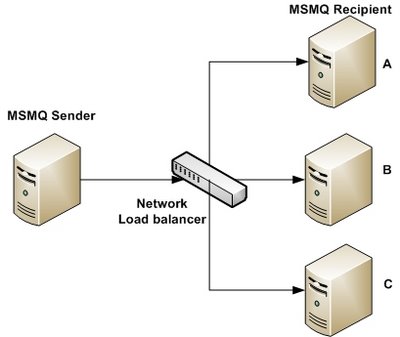I am currently writing a database-driven .Net application which needs to send MSMQ messages load balanced across a variable number of machines.
The case scenario is the following:
A server needs to send MSMQ messages to servers A, B and C (we choose 3 MSMQ message recipients for the purpose of this example). The original idea was to put a network load balancer (NLB) between the machine sending MSMQ messages and the recipients.

If the “MSMQ Sender” machine pictured above sends 75 MSMQ messages, the goal is for machines A, B and C to receive 25 messages each. As we know that a network load balancer distributes load on a connection basis, we were hoping that messages would be load-balanced if the .Net code was creating a new System.Messaging.MessageQueue object for each MSMQ messages sent to the NLB. To be more precise, we were hoping that a new connection to the NLB would be created each time we send a MSMQ message with a new instance of the MessageQueue object.
This was pure speculation and a quick test proved that it did not hold; using a simple network load balancer, all the messages were pushed to a single destination server. This happens because connections are re-used within the MSMQ Windows Service, regardless of how the .Net code is written (as a reminder, the .Net class MessageQueue is just a wrapper around the MSMQ Windows service).
Because traffic is load-balanced on a connection basis (not on a message basis) and because the same TCP connection is re-used by the MSMQ service, the NLB forwards all the traffic to the same destination machine. Would the server send 100 MSMQ messages to the NLB, 100 messages would be forwarded to the same target machine as they are all sent using the same underlying TCP connection.
As we have very little control over the way connections are managed within the MSMQ Windows Service, we had to part away with this simple NLB solution and implement an ad-hoc solution.
We chose to implement the load balancing feature in the .Net application itself. The only addition needed to the existing software is a way to configure it so that it can send MSMQ messages to different queue paths. A simple isolated class, module or piece of code could easily do that.
Server Load Balancing: Algorithms
Before choosing how to implement the solution, let’s have a look at different ways (algorithms) on how to implement load balancing.
- Random Allocation
In a random allocation, the traffic (MSMQ messages in our case) is assigned to any server picked randomly among the group of destination servers. In such a case, one of the server may be assigned many more requests to process while the other servers are sitting idle. However, on average, each server gets an approximately equal share of the load due to the random selection.
Pros: Simple to implement.
Cons: Can lead to overloading of one server or more while under-utilization of others. - Round-Robin Allocation
In a round-robin algorithm, the traffic is sent to the destination server on a rotating basis. The first request is allocated to a server picked randomly from the group of destination server. For subsequent requests, the algorithm follows the circular order destination servers are listed. Once a server is assigned a request, the server is moved to the end of the list and the next server is chosen for the following request. This keeps all the servers equally assigned.
Pros: Better than random allocation because the requests are equally divided among the available servers in an orderly fashion.
Cons: The round robin algorithm is not good enough for load balancing if technical specification of the servers part of the destination group differs greatly (making that the load each server can handle differs greatly). - Weighted Round-Robin Allocation
Weighted Round-Robin is an advanced version of the Round-Robin that takes in account server capability. In case of a weighted round-robin, one can assign a weight to each server in the destination group. For example, if the server group consists of 2 servers and that one server is capable of handling twice as much load as the other, the powerful server gets twice the weight factor. In such a case, the application would assign two requests to the powerful server for each request assigned to the weaker one. In effect, a server with more weight will receive load proportionally to their weight factor.
Pros: Takes care of the capacity of the servers in the group.
Cons: Does not consider advanced load balancing requirements such as processing time for each individual request.
We have chosen the Weighted Round Robin algorithm as it is the most advantageous load balancing algorithm to implement easily.
We have chosen to implement the algorithm in T-SQL, but it could be easily implemented in a singleton class in any language such as C# or Java. I will explain why and how in a next blog post: T-SQL Weighted Round Robin Algorithm.
